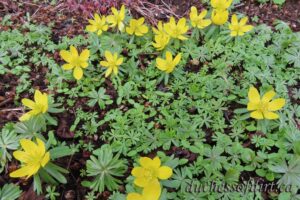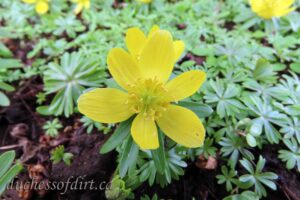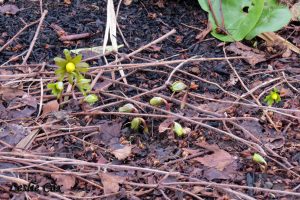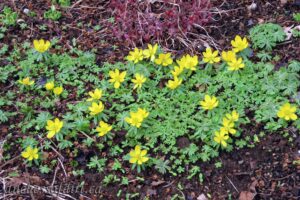 Eranthis hyemalis
Eranthis hyemalis
(air-AN-thiss hye-em-AY-liss)
syn. Aconitum hyemale
Family: Ranunculaceae
Common name: winter aconite; winter hellebore
Zone: 4 – 9
Height: 4 – 6 in (10 – 15 cm)
Spread: 4 in (10 cm)
Aspect: sun; partial shade
Soil: fertile, humus-rich; well-draining
Water: moderate
 Description: A spring-flowering, low growing, herbaceous, tuberous perennial. Rich green-coloured, palmately lobed basal leaves form a rosette on top of the soil. Each upright stem supports a bright yellow, cupped flower cradled on a collar of deeply lobed stem leaves. Flowers have a sweet, honey scent. It is a spring ephermeral…with leaves emerging in late January, setting flowers with seed pods following. The whole process taking a mere two to three months before the plant disappears below ground again to rebuild its strength for a beautiful floral display again the following winter.
Description: A spring-flowering, low growing, herbaceous, tuberous perennial. Rich green-coloured, palmately lobed basal leaves form a rosette on top of the soil. Each upright stem supports a bright yellow, cupped flower cradled on a collar of deeply lobed stem leaves. Flowers have a sweet, honey scent. It is a spring ephermeral…with leaves emerging in late January, setting flowers with seed pods following. The whole process taking a mere two to three months before the plant disappears below ground again to rebuild its strength for a beautiful floral display again the following winter.
Special Notes: Native to southern Europe from Italy to Bulgaria, and including Turkey. Has naturalized outside of its native boundaries. Introduced into English gardens around 1596, it has since spread to establish naturalized colonies in the wild in that country.
Eranthis hyemalis is a winter hardy understory plant, preferring placement under deciduous trees whose bare branches allow sunlight to reach the ground throughout the winter months.
This plant is non-aggressive…it does not run rampant through the garden. Indeed, many gardeners bemoan the fact their golden patch of winter aconites does not increase. Propagation is by fresh seed…either by allowing the plants to form seed pods and self-scatter, or buying very fresh seed from a reliable source and immediately sowing them. Germination time is long, and needs winter stratification temperatures to break dormancy. Cleaning up the garden bed or walking on the soil are two main reasons why Eranthis spp. are difficult to grow.
 If you have already established a patch of Eranthis in your garden, you can start a patch in another area of the landscape by carefully digging up a few plants…after flowering but before the green leaves disappear underground. Be sure to provide some compost as this genus loves humus.
If you have already established a patch of Eranthis in your garden, you can start a patch in another area of the landscape by carefully digging up a few plants…after flowering but before the green leaves disappear underground. Be sure to provide some compost as this genus loves humus.
If you purchase tubers from a nursery, buy as fresh as you can. Dried out tubers usually do not produce plants…although some gardeners have had limited success by soaking dried tubers before planting.
Deer, rabbit, and squirrel resistant. Not many disease problems, although smut…black spots appearing on leaves, caused by a fungus in the genus Urocystis…can be devastating. It is best to carefully dig up the infected plant and place it in the garbage…before the black spores are released to infect other plants in the colony.
 In our zone 7a garden: We started our patch of Eranthis hyemalis sometime around 2006 or 2007 from fresh seed gathered from a neighbour’s plants. The seeds were immediately sown underneath the Viburnum opulus ‘Roseum’ where they flourished and multiplied to become a delightful patch. (Sadly, the viburnum had to be removed due to a serious infestation of viburnum leaf beetles. A native Physocarpus opulifolius ‘Monlo’ Diablo® has been planted in its place.)
In our zone 7a garden: We started our patch of Eranthis hyemalis sometime around 2006 or 2007 from fresh seed gathered from a neighbour’s plants. The seeds were immediately sown underneath the Viburnum opulus ‘Roseum’ where they flourished and multiplied to become a delightful patch. (Sadly, the viburnum had to be removed due to a serious infestation of viburnum leaf beetles. A native Physocarpus opulifolius ‘Monlo’ Diablo® has been planted in its place.)
I am very fond of the bright little winter aconite flowers as they are a ray of sunshine bursting forth in the dead of winter…instilling hope that spring is finally on its way.
Caution: All parts of the plant are poisonous…the toxic compounds of note are cardiac glycosides. These are not as toxic as those toxins found in Aconitum spp. but still to be avoided ingesting.
RHS Award of Garden Merit 1993; Great Plant Pick 2012
Posted on February 11, 2017; updated on February 24, 2025
